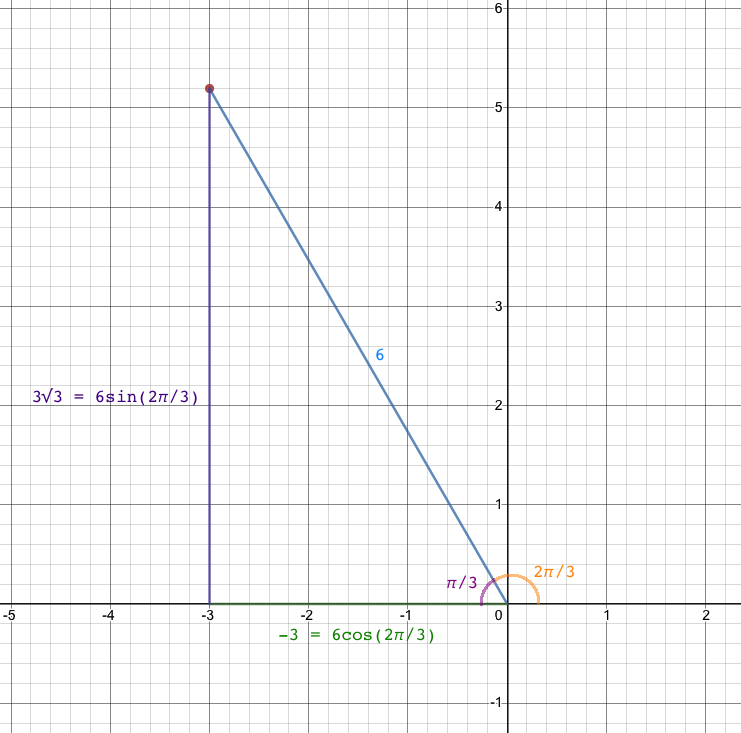2.
Let (x, y) be the solution to the system. We know it is true that
y = (3x + 15) / 4
We also know it is true that:
x2 + y2 = 36
Since y = \(\frac{3x+15}{4}\) we can substitute \(\frac{3x+15}{4}\) in for y
x2 + \((\frac{3x+15}{4})^2\) = 36
x2 + \((\frac{3x+15}{4})(\frac{3x+15}{4})\) = 36
x2 + \(\frac{9x^2+90x+225}{16}\) = 36
Multiply through by 16 to eliminate the denominator
16x2 + 9x2 + 90x + 225 = 576
Combine like terms
25x2 + 90x + 225 = 576
Subtract 576 from both sides of the equation
25x2 + 90x - 351 = 0
We can use the quadratic formula to solve for x
x = \(\dfrac{-9\pm12\sqrt3}{5}\)
We can use the equation y = (3x + 15) / 4 to find the y-coordinates of the intersection points.
When x = \(\frac{-9\ +\ 12\sqrt3}{5}\) , y = \(\frac14\cdot(\ 3(\ \frac{-9\ +\ 12\sqrt3}{5}\ )+15\ )\ =\ \frac{12\ +\ 9\sqrt3}{5}\)
When x = \(\frac{-9\ -\ 12\sqrt3}{5}\) , y = \(\frac14\cdot(\ 3(\ \frac{-9\ -\ 12\sqrt3}{5}\ )+15\ )\ =\ \frac{12\ -\ 9\sqrt3}{5}\)
So the intersection points are:
\(\big(\frac{-9\ +\ 12\sqrt3}{5},\ \frac{12\ +\ 9\sqrt3}{5}\big)\) and \(\big(\frac{-9\ -\ 12\sqrt3}{5},\ \frac{12\ -\ 9\sqrt3}{5}\big)\)
Check: https://www.desmos.com/calculator/jfndjchrhd
We can find the distance between those two points using the distance formula.
distance = \(\sqrt{\Big(\frac{-9\ +\ 12\sqrt3}{5}\ -\ \frac{-9\ -\ 12\sqrt3}{5}\Big)^2\ +\ \Big(\frac{12\ +\ 9\sqrt3}{5}\ -\ \frac{12\ -\ 9\sqrt3}{5}\Big)^2}\)
distance = \(\sqrt{\Big(\frac{24\sqrt3}{5}\Big)^2\ +\ \Big(\frac{18\sqrt3}{5}\Big)^2}\)
distance = \(\sqrt{\frac{1728}{25}\ +\ \frac{972}{25}}\)
distance = \(\sqrt{\frac{2700}{25}}\)
distance = \(6\sqrt3\)
.1.
P is a point on the line y = x and Q is a point on the line y = 7x.
So we can say...
Let P be the point (a, a) where a > 0
Let Q be the point (b, 7b) where b > 0
And O is the point (0, 0)
Now we can make this equation:
the distance between O and P = the distance between O and Q
√[ a2 + a2 ] = √[ b2 + (7b)2 ]
Square both sides of the equation
a2 + a2 = b2 + (7b)2
a2 + a2 = b2 + 49b2
Combine like terms
2a2 = 50b2
Divide both sides by 2
a2 = 25b2
Take the positive square root of both sides
a = 5b
the slope of PQ = the slope between the points (a, a) and (b, 7b)
the slope of PQ = \(\dfrac{a-7b}{a-b}\)
Substitute 5b in for a
the slope of PQ = \(\dfrac{5b-7b}{5b-b}\)
Combine like terms
the slope of PQ = \(\dfrac{-2b}{4b}\)
Reduce the fraction by 2b
the slope of PQ = \(-\dfrac{1}{2}\)
Here is a graph for this problem: https://www.desmos.com/calculator/c9sjxvalqw
Using trig we can make this triangle:

z = -3 + 3√3 i
Substitute 6 cos( 2π/3 ) in for -3 and 6 sin( 2π/3 ) in for 3√3
z = 6 cos( 2π/3 ) + 6 sin( 2π/3 ) i
Move the i to the front of the term
z = 6 cos( 2π/3 ) + 6 i sin( 2π/3 )
Factor 6 out of both terms
z = 6 [ cos( 2π/3 ) + i sin( 2π/3 ) ]
cis( x ) = cos( x ) + i sin( x ) so cos( 2π/3 ) + i sin( 2π/3 ) = cis( 2π/3 )
z = 6 cis( 2π/3 )